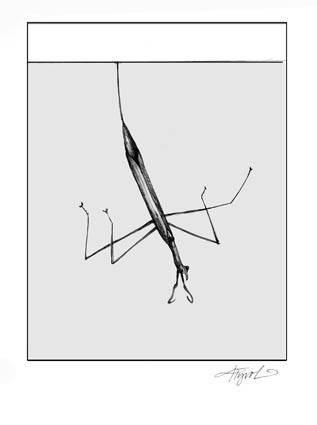By Declan McCabe
Recently, my daughter participated in Odyssey of the Mind, a creative problem-solving competition devoted to ingenuity and team work. As an entomologist, I was thrilled to learn that the program calls its highest award the “Ranatra fusca.” Not only was the award named for an insect, but an aquatic insect, and a particularly fascinating one to boot.
Ranatra fusca is the Latin name for a water scorpion, a creature little known to the general public but familiar to those of us who wield nets in ponds. This insect bears only a passing resemblance to real scorpions (which are arachnids, not insects). It does sport what looks like a prominent tail (more about that later), but lacks any sort of stinger. It can, however, be quite lethal if you happen to be an aquatic insect, tadpole, or even a small fish.
Humans have nothing to fear from water scorpions. Unlike their larger cousins, the giant water bugs known as “toe biters,” water scorpions are not known for biting on toes or other human parts. Besides, they live in tall weeds where entanglement would be a far greater health hazard than insect nibbles.
Despite measuring in at more than three inches, these amazing predators are easily overlooked by casual observers, and by their prey. They combine stealth with uncanny camouflage. They hold their long, stick-like, brown bodies parallel to the vertical stalks of plants and can remain perfectly still while breathing through a snorkel.
Unlike the snorkel I use when observing aquatic insects, water scorpion snorkels sprout from their rear ends. This is what looks like a tail, and inspired their common name. Rather than a single tube, a water scorpion snorkel consists of two half cylinders held tightly together to create an airtight pathway (at the insect’s death, these often separate). The snorkel conveys air to spiracles, or breathing holes, on the abdomen.
The snorkel is impressive enough, but the water scorpion has another breathing trick in its repertoire. Once air reaches the spiracles, water repellent hairs trap it within a bubble. What this means is that the water scorpion has an on-demand scuba tank. When fully submerged below the water’s surface, it can still breathe from this reserve of air.
But wait, there’s more. When winter ice blocks access to the surface, the bubble switches function from a scuba tank to a gill. Oxygen from the water diffuses continually from the water into the bubble. The water scorpion can survive on this diminished air supply, aided by a dramatic reduction in metabolic rate as the temperature drops.
Thanks to these adaptions, water scorpions can wait for long periods until their next meal swims by. Then they give a nightmare performance of the old AT&T slogan “reach out and touch someone.” Long raptorial front legs whip out like jackknives and firmly snatch the hapless prey right out of the water column. Things just get more fiendish from there.
Actual scorpions use their claws to quickly tear up their prey and thrust the fragments between their jaws. As painful as that may sound, death by water scorpion is a worse way to go – a drawn-out and gruesome affair. The insects skewer their prey with a pointed mouthpart and suck out their fluids as if through some sort of barbaric drinking straw. At the end of the meal, all that’s left is an empty husk.
When my colleague Scott Lewins takes his Saint Michael’s College students out for their first day of insect collecting to Gil Brook in Winooski, water scorpions are high on the list of coveted specimens. For the budding entomologist, what could be cooler than a large insect that looks like a stick, preserves very well, and is easy to identify? We have specimens in our teaching collection that date to the 1990s with their spindly limbs and separated breathing tubes still intact.
Back on land, it was gratifying to see the excitement on my daughter’s face and on the faces of her teammates when, after three years of competition, they received the Ranatra fusca award. An insect with Swiss army knife appendages, scuba gear, and camouflage is the embodiment of out-of-the-box thinking.
Declan McCabe teaches biology at Saint Michael’s College. His work with student researchers on insect communities in the Champlain Basin. The illustration for this column was drawn by Adelaide Tyrol. The Outside Story is assigned and edited by Northern Woodlands magazine, and sponsored by the Wellborn Ecology Fund of New Hampshire Charitable Foundation: [email protected].
Water Scorpions: underwater assassins




